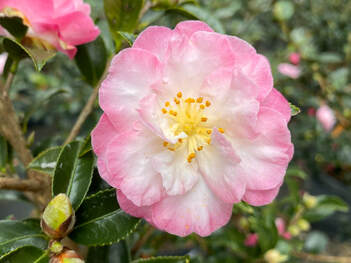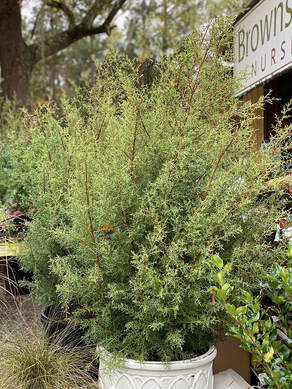 Trees and Shrubs: There are other shrubs that bloom in the winter, but certainly none as showy as camellias. And these plants absolutely love our southern climate. If you have space in your garden for multiple varieties of camellias, you can have bloom starting in October and continuing through March and possibly even April. So continue to visit the nursery to see what camellias are blooming now and take some home with you. They will bring delight for years to come. Now is also the time of year that one can learn to appreciate the form and structure of trees. For most people, when thinking of crape myrtles, their richly colored blooms will come to mind. But for me, their richly hued bark and sinuous limbs come to mind first. If I were choosing a crape myrtle variety, I would be visiting the nursery now when the bark and branches are easily seen. Check out the potted plants on offer but also take time to see the mature varieties planted at the nursery. These will give you a good idea of their mature size but also let you appreciate the colors and form of bark, trunk and limbs.  Evergreen trees come in all shades of green from deep, dark green to Kelly green to incredible tints of blue-green. Some evergreen plants are needed in the landscape for winter interest and one of my favorites is the Clemson University selection of the Arizona cypress, Carolina Sapphire. These trees are actually tolerant of our southern climate despite their common name and origin. All they need is good drainage. They are drought tolerant and even salt tolerant once established. And the color is truly blue. Like many of the needled evergreens they also make a good outdoor Christmas tree. If you prefer broad-leaf trees there are plenty to choose from among the magnolias, hollies, cherry laurel, loquat, and live oak. Evergreen shrubs that can eventually become small trees are tea olives, banana shrub, wax myrtle, Loropetalum chinense and non-dwarf Camellia sasanqua varieties. All of these plants can contribute branches for December holiday decorations indoor and out. Use them to make wreaths and swags, and to dress tables and mantles. Clemson’s HGIC has more on decorating with fresh greenery at: https://hgic.clemson.edu/factsheet/holiday-decorating-with-fresh-greenery/ Perennials and Annuals: By now we may have experienced frost that has burned both your perennials and annuals. A little trimming and dead-heading should take care of any damaged parts. For perennials without hollow stems and seed heads that attract birds, any dead tissue can be cut just above soil level. Continue to remove dead and frost damaged flowers from winter blooming annuals to encourage more blooms. |
Categories
All
Archives
June 2024
|

 RSS Feed
RSS Feed



